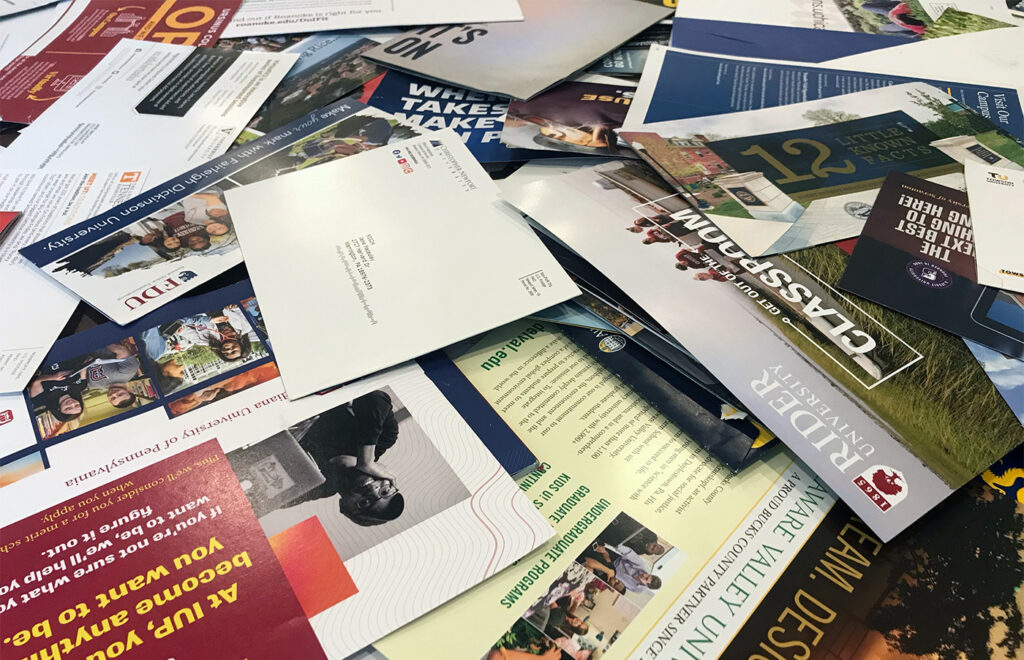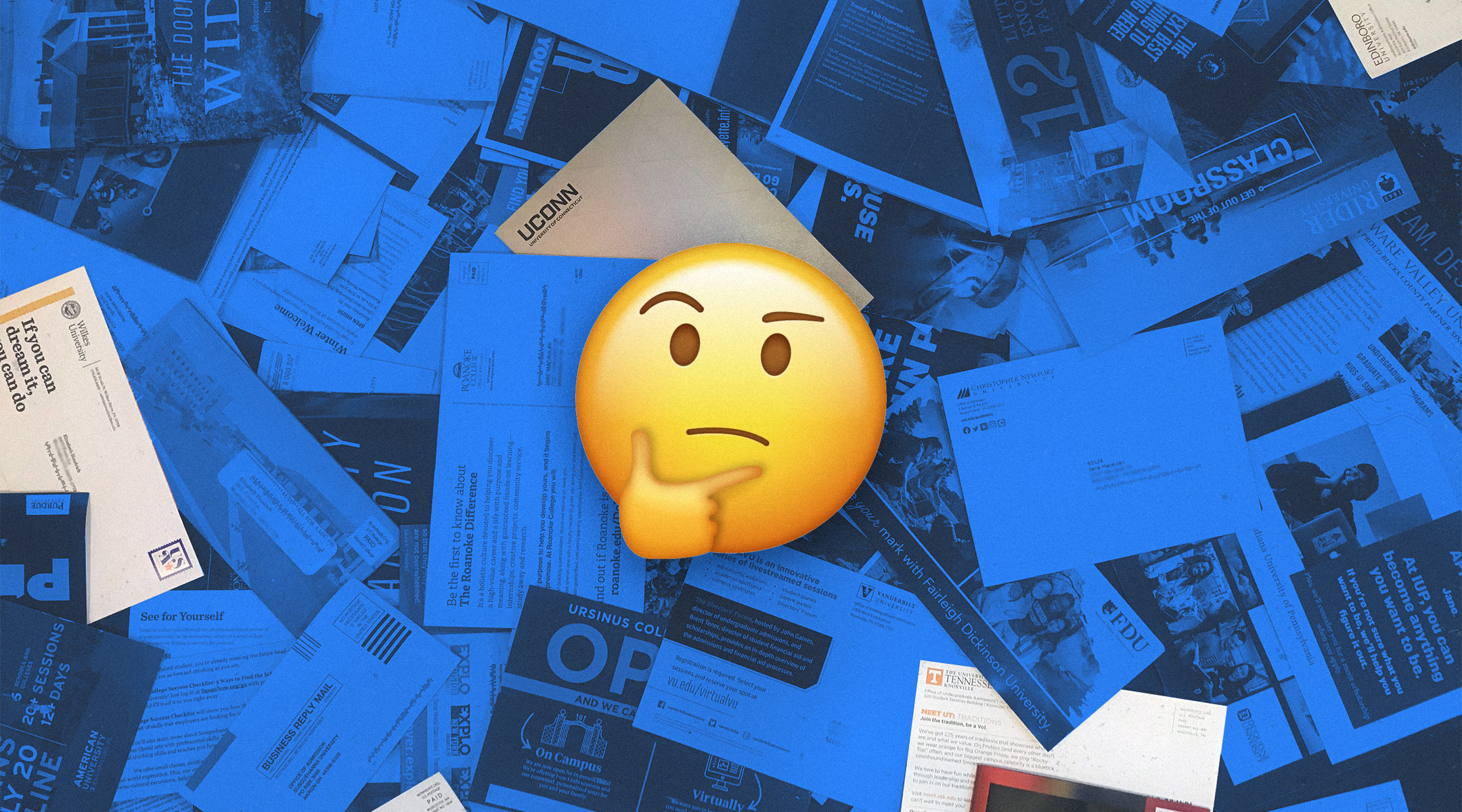Jane M. is going places. Specifically, she’s going to go to a good college in the fall of 2021. Exactly which one is still undecided, but as her senior year begins, she’s getting ready for her applications – and sifting through a sea of print and digital communications from colleges and universities big and small, some who know a little bit about her, and many of which clearly know very little about her.
She’ll have options. She’s the captain of the mock trial team; the president of the Science Olympiad team; the founding member of her school’s cooking club (which she linked to the school’s autistic support group as a therapeutic outlet for those kids); a Girl Scout; and she’s taken just about every AP science and math course her high school offers, because she’s intent on studying biomedical engineering.
Meanwhile, she’s at the receiving end of what is hardly a new approach in higher education: blanket-contacting prospective students whose names were acquired through paid lists with the logic that the wider net a college casts, the more fish they’ll scoop up. But in this day and age – with tight budgets and more digital targeting capabilities than ever before – is that still the right approach? Should small, mid-tier liberal arts colleges be targeting Jane M., who will likely have her pick of premier schools, and who aspires to study biomedical engineering at a major university? Does the decades-old blanket-marketing approach in higher education still make sense?
Jane’s uncle happens to be our very own Tom Kegelman, Electric Kite’s Managing Director of Higher Education Strategy. So, to dig in deeper to how colleges and universities are targeting and communicating with his niece, we interviewed her about her experience, then asked Tom to assess the strategy behind those tactics.
Electric Kite Question:
What kinds of communications are you getting? Is it a lot of physical stuff in the mail or is it a lot of emails? Is it a lot of targeted social media?
Jane M. Answer:
So, I personally get all three. I’d say I get mostly emails. I’m blasted with emails. It ranges from specific programs that they think I’d be interested in applying to, to others that are more or less telling me, “You’d get in. We’re going to waive your application fee. Once you get in, we’re going to give you this scholarship.”
Tom Kegelman Analysis:
Email is a relatively inexpensive and efficient tactic for most enrollment management offices to deploy, so it’s no surprise that Jane’s spam filter is cranking. The mistake that’s made way too often is assuming prospective students are ready to apply or register for an event before they know the school differentiators.

EC: What kinds of schools are giving you those messages that you’re likely to get in? Is it the Berkeleys of the world, or are they lower-tier schools?
JM: It’s lower-tier schools. I don’t really know much about them. The ones I’ve gotten just today were from Cabrini and Rollins. I don’t really know much about those schools. I have actually noticed that, on social media, Berkeley and Hopkins have begun following me. The Hopkins Mock Trial Team has begun following me and reached out to me a couple times. I’ve gotten special Harvard things in the mail, like mock trial stuff. And, Berkeley, just their general account began following me.
TK: Very interesting to see how schools can leverage individual niche offerings to personally reach out to prospects. This obviously involves more work, but the payoffs that can be very rewarding.
“When I see three emails in a row from Sweet Briar College, saying they want me to be on their field hockey team, when I haven’t played field hockey in a year, that’s not necessarily good.”
EC: Is that cool, or is that creepy?
JM: I don’t really think of it as creepy because there was a scout at one of my mock trial competitions for Harvard. It wasn’t quite a scout, but they were there to watch someone else. And then, while they were there, they came up to me and gave me their card. So, I think that’s how they know about me, but I don’t know for sure.
TK: When personalization is used correctly, it can be perceived as a benefit as opposed to intrusive. The same holds true for the larger digital marketing strategy. What content are you offering your prospects that they’ll positively view your campaigns?
EC: So, is any of this making you think about these schools in ways that you hadn’t before?
JM: Yeah. According to The Princeton Review, Hopkins is the no. 1 college in America for my intended major, so it has always been a college that I was interested in. But, them reaching out to me made me look into them more and get more interested in the program there, versus just it’s another option.
TK: As I’ve reviewed the stacks of marketing material Jane has received, it’s interesting to see how individual colleges and programs within universities market directly to prospects. Sometimes, as is the case with Cornell’s LIR, there seems to be too much of an emphasis of creating a sub-brand and deemphasizing the master brand that has much more equity and familiarity.
EC: What about those emails from schools that are offering to waive admission, application fees, or promises of financial aid? Are you thinking about any of those schools now?
JM: In general, I don’t really look at schools that I haven’t heard of because I believe that there’s something to go with the name value of a school in the sciences. I want one that has some name value to go along with upper graduate school admissions. There is an exception to that. The first one that I remember reading was for the Florida Institute of Technology. They offered to waive my application fee and let me apply early. I don’t remember how they wanted me to do it, but it was a Common App that I could apply before August 1st.
TK: Two possible big takeaways. First, this exemplifies why it’s so critical to be the first to reach a prospect. This general rule holds true for undergrad and graduate recruitment. Second, ensure you know which personas actually convert and save your marketing budget for other areas of the funnel.
EC: So, it sounds like you’re not applying to Florida Institute of Technology, but they got on your radar, and you considered it?
JM: Yes.
TK: Sure, Jane didn’t apply to Florida Institute of Technology, but if they weren’t the first to contact her it’s likely their efforts would’ve been lost within the impending marketing tsunami.
EC: Was there anything that schools did to reach out to you that gave you a negative impression of them?
JM: There are some schools that just constantly email me. I just get barraged with stuff from them. It makes me think that they’re desperate almost, when they email me sometimes more than once a day. That’s a lot. I don’t go through all of the emails I get from colleges, but when I see three emails in a row from Sweet Briar College, saying they want me to be on their field hockey team, when I haven’t played field hockey in a year, that’s not necessarily good.
TK: Clearly a case where personalization went wrong. That said, Sweet Briar has made a tremendous turnaround with enrollment so it would be interesting to see if this type of granular marketing has made a positive overall impact.

EC: Do you know roughly the most number of emails you’ve gotten from a single school? If you’re getting three a day, and I imagine it’s been going on for a while, that’s probably a lot of emails.
JM: Yeah. I started getting emails after my PSAT in 10th grade. So, I guess almost two years ago now. But … I don’t know. I just get so many that sometimes I just block the emails or send them to my spam. Spam are really the ones that I have gotten so many from. Like Elizabethtown, I get a lot from. In the past month from them, I want to say 15. And, they all don’t really say anything that’s new about them. If there’s a new college that I’ve never heard of, I generally click on the first one from them. And then, I just ignore the rest. But, I’d say the first email that you send someone has to get them interested, at least somewhat.
TK: This is why marketing lists become so diluted and bastardized. If your recipients are flagging your emails, your overall deliverability will be impacted.
EC: What in that first email gets you interested or would make you interested to learn a little bit more?
JM: Just tell me something that’s unique to the program, what differentiates Elizabethtown from any other college, what makes that one special. Because most colleges, even if it’s not big, they try to have something that’s uniquely them. And, they don’t always say that. They always say, “Join us for this general session. Join us for any other thing.” Just very general about the school and why you should go to the school. But, they don’t tell me anything new.
TK: My niece and I are clearly cut from the same cloth. Tell a story. If there’s nothing particularly unique or interesting about your school, then try to infuse dynamic content within your CRM to tell stories that would compel your most important personas to take action.
EC: There’s nothing in what you’re describing that sounds different other schools.
JM: Yeah. They normally have a picture of a couple smiling kids, and they say, “Look how much fun you could have. You could fit in here, and you could make this home in the next four years.” Which is good. You want the students to feel like they could see themselves there. But, you also want students, especially top students, who would have options, to know why this school is the best. I’m not worried about getting into colleges. I’m just trying to pick what colleges I would be best at or would be best for me.
TK: Ah, the happy, smiling students sitting in a circle underneath a tree approach. That was so 2004. Come on, marketers. Stop being lazy.
“I’d say the first email that you send someone has to get them interested, at least somewhat.”
EC: When you are checking out a school, do you scroll through their social media and look at all of the different things that they’re saying?
JM: I, in general, don’t really follow the main pages of many schools. I follow the clubs or the program at the schools.
TK: It’s sometimes a logistical hurdle for university marketers to influence individual programs and colleges, but if this tactic helps attract top candidates, then perhaps more time should be involved ensuring social media is done effectively. Analyze Google Analytics and perhaps it makes sense to take the three most popular clubs and test those first.
EC: What print materials have you received that have stood out to you?
JM: It ranges from just like a postcard type thing to a thick packet or book that they’ll send me. It definitely does show the level of interest that a school has for you. From Hopkins, for example, I just got this little card first. And then, a couple weeks later, I got one of the big books. The cool thing about the book was as you flip through it tells you, obviously, all of the information about the school and the biomedical engineering program. But, then it folds out into this gigantic poster, which is their main campus, which stood out to me. Then, I also got one from the University of Delaware, which, it didn’t make me interested in the program. But, it did stand out. One of the things where as you pull, it shows something just by the alternation of light and dark.
TK: For a while, many schools were questioning the value of print relative to digital media. As Jane pointed out, sometimes it’s not really the medium, rather it’s the message and is it hitting the right mark? Print isn’t dead. Lazy and gimmicky creative is.

EC: You’re a rising senior, so hopefully Covid-19 won’t directly impact your college plans. But do you have friends who are considering taking a gap year or going somewhere local for the first year?
JM: I don’t. All my friends are still planning to go to college the last I talked to them. But, that being said, I have talked to my guidance counselor, and she said about a third of last year’s senior class is going to take a gap year. And, of my class … Each grade in my school is about 600 people, so that’s 200 people just from my school that are taking a gap year.
TK: According to data from Simpson Scarborough, about 40 percent of incoming freshmen are likely to change their plans of attending a four-year college. Schools will know those numbers by the end of September, once the add/drop period closes, and tuition payments are due.
EC: How much are schools communicating their stances on social justice and fighting racism, the actions that they’re taking, and how much do you want to be hearing from them about that?
JM: Many schools are saying, “We’re going to support the Black Lives Matter,” but aren’t really doing anything to demonstrate how they’re going to help or how they’re going to change the community that they actually do have control over, even.
TK: Many brands are guilty of playing lip service to social issues such as BLM. Just google “NHL and Black Lives Matter” and you’ll see how a billion-dollar brand was initially run over by the Zamboni of public opinion. Many university brands are/were in the same boat. This is an excellent opportunity to continue the narrative of conveying the stories your institution (faculty, students, administration, and community) are doing and showcase them in a meaningful, authentic way.
EC: How important is it to you in your decision-making process, where schools stand in this and the actions that they take?
JM: I think it’s very important because it shows how much the schools value the safety and mental security of the students who are going to go to their school. If they’re just blowing off an entire community of their school who’s saying, “This isn’t right this is happening,” and just saying, “We support you,” but not doing anything to address it, it doesn’t really bode well.
TK: Once again, it’s critical to show the substance of your school’s decision-making through real stories. Video is an excellent way to accomplish this.
EC: Through what schools email you and the things that they target you with on social media, do they address any of that at all?
JM: No.
EC: Would you want them to?
JM: I think on their social media pages, they should. From the ads and stuff I’ve been getting, those are, again, just very general [about applying], saying, “Apply,” “Click here for more information,” and it’s always just very broad. Same as the emails. Because schools do have such a big platform, they should use it.
TK: When buying a car, would you start the financing paperwork before you know which make and model you want? Probably not. So don’t assume your prospects are ready to apply before they get to know your school. Follow the buyer’s journey of awareness, consideration, and decision phases of your content strategy.



